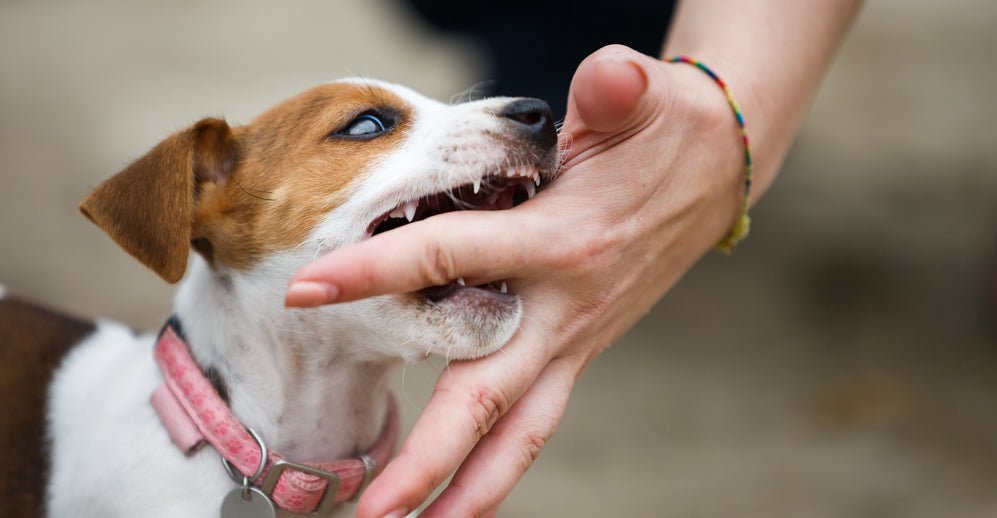![]() Listen to the Podcast
Listen to the Podcast
Dogs are masterful with their mouths. They are quite capable of being able to exert or remove pressure very accurately. That is why when people say, "he bit by accident," in all likelihood, they are wrong.
There's truly only 2 reasons that a dog will put teeth on a human. They either meant to or they've never been taught not to.
Let's explore both:
They Meant To
As I said, dogs are masterful with their mouths. A dog can pick up a raw egg and carry/hold it while they navigate an obstacle course. If a dog bites you, they meant to bite you. There is usually a warning of some sort and the warning will be variable based on the dog. Some dogs will offer seemingly little. You might see a lip lick, a bit of whale eye, ears pinned back, etc., while other dogs may growl extensively, snap and intentionally miss, snarl, etc. Either way, if they bite and make contact, it was likely an intentional act.
They Haven't Been Taught to be Careful
The more likely situation with most dogs who do not have aggression issues is that they don't understand that it's their job to be careful with their mouths. Bite inhibition is engrained in a dog at a young age; usually between 3 - 5 months of age. It's not that it's impossible to teach at a later age, but it's definitely more difficult as the rehearsal of being careless will likely leave a lasting impression on the dog.
So how do you teach a puppy good bite inhibition? It's all about consistency. Here are a few exercises that we use and recommend.
Taking Food Gently
This is where we start with puppies. Some will be naturally inclined to take food gently, but in my experience, they are few and far between. My 5-month-old puppy, Ned, was the first puppy I've ever had who was naturally gentle when taking food. That's super for me now, but every puppy prior to him has been the opposite.
One of the first exercises we recommend to new puppy owners is this: offer your dog a treat and make sure they ONLY get it if they are gentle about trying. To make it easier for the dog, you'll want to set it up so that it's simple for them to have success. Initially, hold your food in the base of your hand rather than between your fingers. This will make it easier for a young puppy to be right. Offer the treat to your dog. If you feel teeth at all, simply remove your hand. Within a few seconds, try again only releasing the treat when your dog is gentle.
We've discussed this process previously in a YouTube video
The Roll of Tug in Bite Inhibition
Incidentally, while Ned was naturally gentle taking food, he was the polar opposite when playing with toys. He had zero bite inhibition when the toys came out. The first week or so of tugging with Ned resulted in scratches, scrapes and even a few small punctures from those needle-like puppy teeth. While it was hard on my hands and arms, I was actually glad... I'm sure that sounds quite shocking, but let me explain. This gave me a great vessel to convey the lessons of bite inhibition. Ned wanted to play with the toy and wanted to play with me with the toy, he just didn't understand that it hurt when he missed the toy! That was my job to teach. Ned quickly learned that every time he missed the toy and hit skin, the game and all of his fun was over. Every repetition of the game ending because I felt teeth made Ned more and more aware that he needed to be responsible and gentle with his mouth. With some consistency, once we were on week 2, he had built a lot of understanding of how to inhibit his bite and I was happy because my hands were healing.
Always remember that excuses don't serve us well with dogs. Believing that it is an accident when you feel teeth or worse, sustain a bite, will only make matters worse in the long run. If you are working with a puppy, be sure to be consistent with your bite inhibition lessons to breed awareness and responsibility into how your puppy uses their mouths. If you have an older dog who is nipping or biting, we strongly encourage you to find a qualified behaviourist in order to identify the reasons and plan a course of action to make that dog safe.
As always, Happy Training!
|
|
Hi! I'm Shannon and I joined the McCann team in 1999 while training Quincey, my wonderful and spirited Rottweiler, to have good listening skills. I'm the Director of Online Training and Content for McCann Professional Dog Trainers and I enjoy writing about dogs and dog training for the McCann blog. I currently share my life with 2 Tollers (Reggie & Ned) and I love helping people develop the best possible relationship with their 4-legged family members. |


